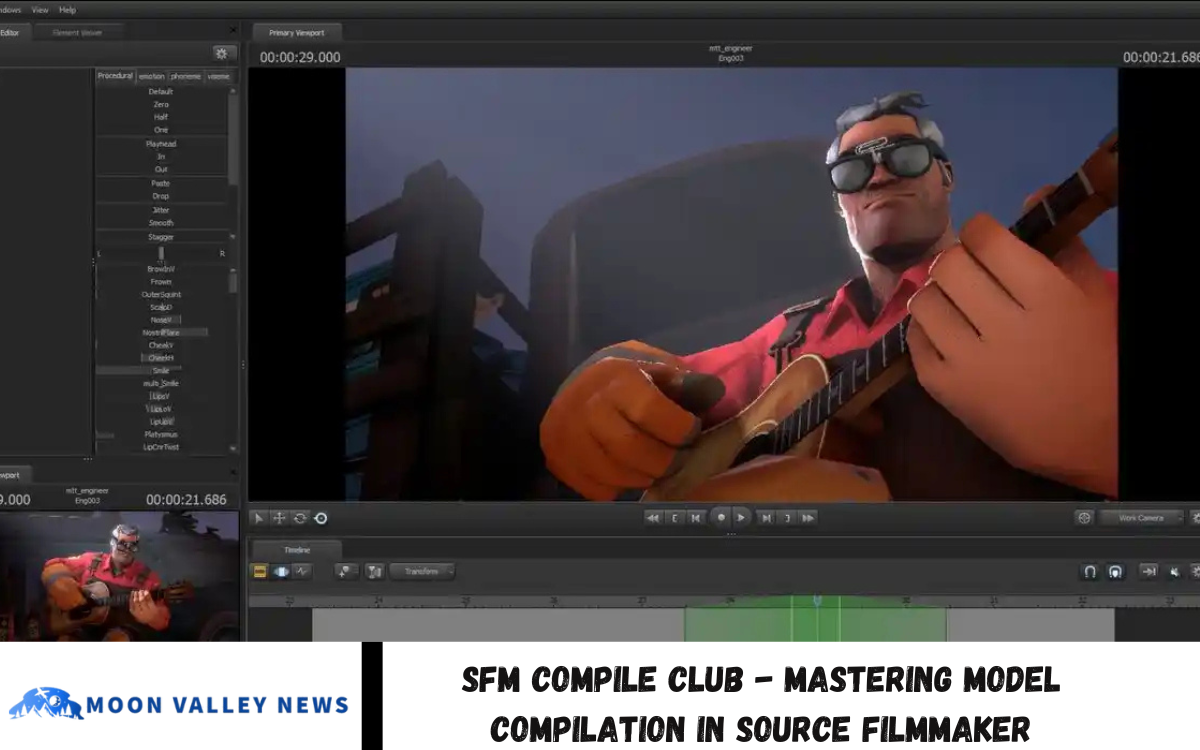The World of Source Filmmaker (SFM) offers a unique and immersive platform for creating cinematic animations. Still, one of the most essential skills for any SFM artist is mastering the art of model compilation. Welcome to the SFM Compile Club, a space dedicated to exploring the intricate process of compiling models for use in your SFM projects. Whether you’re a beginner or an experienced user, understanding how to properly compile models can be the key to unlocking the full potential of your animations.
Model compilation involves converting 3D models into a format that SFM can read and animate. This process includes transforming assets like textures, rigs, and materials into a cohesive, optimized file. It ensures smooth performance and high-quality visuals for your projects. The Compile Club provides a comprehensive guide, tutorials, and resources designed to simplify this often complex task so that you can focus more on creativity and less on technical hurdles.
By joining the SFM Compile Club, you’ll gain insights into the tools, workflows, and techniques that make model compilation an art form in itself. From troubleshooting common errors to mastering advanced compilation methods, this community is here to help you elevate your SFM projects to new heights.
What is Model Compilation in Source Filmmaker?
Model compilation in Source Filmmaker (SFM) refers to the process of converting 3D models and assets into a format that can be read, displayed, and animated within the SFM software. This process is crucial for bringing custom models, textures, and rigs into the world of SFM, allowing you to create detailed and dynamic animations.
When you create or download a 3D model, it’s typically in a raw format that SFM cannot directly use. Compilation transforms these models into the necessary format (.mdl) by processing elements like textures, materials, and rigs, making them compatible with the SFM platform. The process ensures that the model is optimized for animation, adequately lit, and ready to interact with other assets within the scene.
Model compilation typically involves using a tool called Crowbar. This tool takes source files (like .qc scripts, meshes, and textures) and compiles them into a final .mdl file that SFM can work with. This is a fundamental step in the workflow for SFM creators, ensuring that the models look and perform as intended in animations, regardless of their complexity or design.
Why Model Compilation is Crucial for SFM Animations?
Model compilation is a critical step in the creation of Source Filmmaker (SFM) animations, as it directly impacts the performance, quality, and flexibility of your project. Here are several reasons why it’s essential:
- Compatibility with SFM: Raw 3D models are typically not in a format that SFM can understand. Model compilation converts assets into the proper .mdl format, making them usable within the software. Without this step, your models won’t be recognized or accessible for animation in SFM.
- Smooth Animation Performance: When models are compiled correctly, they are optimized for SFM’s engine. This ensures that they function properly during animation, minimizing glitches, texture errors, or crashes and allowing for smooth, fluid motion throughout your scenes.
- Ensuring Textures and Materials Appear Correctly: Model compilation ensures that all textures, materials, and shaders are applied correctly to your models. Without it, you may encounter issues such as missing textures, incorrect lighting, or unrealistic materials that can affect the final look of your animation.
- Rigging and Bone Setup: Compiling models also integrate rigs and bone structures, which are essential for posing and animating characters or objects. A well-compiled model will have proper rigging, allowing for precise control over the animation process.
- Customization and Flexibility: When you compile a model, you can control various parameters, such as texture quality, bone structure, and optimization. This level of customization is crucial for achieving the exact look and functionality needed for complex animations.
Model compilation ensures that your models are ready to be animated in SFM, offering both technical reliability and creative flexibility. It’s a key process that bridges the gap between raw assets and the finished animation.
Key Tools and Software for Model Compilation
Model compilation in Source Filmmaker requires a few essential tools and software programs to prepare and convert your assets into SFM-ready models. Here are the key tools commonly used by creators:
Crowbar
- Crowbar is one of the most popular tools for compiling and decompiling Source models. It takes .qc script files and associated assets (like SMD or DMX files) and compiles them into .mdl files that SFM can use. It also helps in unpacking existing models for editing.
Blender (or 3ds Max, Maya)
- These 3D modeling programs are used to create and edit the original model. Blender, in particular, is free and widely supported in the community. Exporting models in formats like SMD or DMX is crucial for further compilation steps.
Source SDK / Source Model Compiler (StudioMDL)
- StudioMDL is part of the Source SDK and is the compiler that converts models into .mdl files using .qc scripts. It works in the background of tools like Crowbar to perform the final conversion.
VTFEdit
- VTFEdit converts texture files (e.g., PNG, TGA) into the VTF format required by Source Engine and creates VMT (material) files that define how textures behave on a model.
QC Script Editor (Notepad++, VS Code, etc.)
- Since model compilation is guided by a .qc file (a script that defines how the model should be compiled), having a reliable text editor helps you write and tweak these scripts easily.
GCFScape
- This tool allows you to browse and extract game assets from Valve’s VPK and GCF files. It’s useful for referencing existing models or repurposing assets.
Each tool plays a unique role in the model compilation pipeline. Together, they give you complete control over how your models look, move, and behave in Source Filmmaker.
Read Also: www.eyexconcom for Expert Tips, Products, and Consultations
How to Use SFM Compile Club Resources for Success
The SFM Compile Club is designed to make the model compilation process more manageable, more transparent, and more accessible for creators at all levels. Whether you’re just starting or looking to refine your skills, here’s how to make the most of the resources offered by the club:
Follow the Step-by-Step Guides
- Start with beginner-friendly tutorials that walk you through the entire model compilation process—from exporting your model in Blender to compiling it for SFM using Crowbar. These guides are written in simple language and often include screenshots and example files.
Use Downloadable Templates and Scripts
- The club provides ready-made .qc scripts, rigging templates, and model folders that you can customize for your projects. These templates save time and help you avoid common mistakes, especially when compiling for the first time.
Watch Video Tutorials
- Visual learners can benefit from the club’s video walkthroughs, which show the exact tools, settings, and workflows used by experienced creators. These videos often cover advanced tips like fixing bone errors, adding flexes, or optimizing materials.
Join the Community Forums and Chats
- In community forums and group chats, you can get real-time help, share your progress, or ask questions. Other members and moderators can provide feedback or help troubleshoot issues you might be facing during compilation.
Access the Troubleshooting Library
- Have you encountered a texture bug or rigging problem? The troubleshooting section lists common errors and their solutions, making it easier to get back on track quickly without having to dig through forums or guess what’s wrong.
Stay Updated with New Tools and Techniques
- SFM tools and workflows evolve. The Compile Club regularly updates its resource library with new tools, updated workflows, and improvements based on the latest community feedback and software changes.
By fully engaging with the SFM Compile Club’s resources, you’ll improve your technical skills and gain the confidence to create custom models that enhance your storytelling and animation quality in Source Filmmaker.
Frequently Asked Questions
How can I fix missing textures or error models in SFM?
The Compile Club’s troubleshooting guides help identify common causes of texture errors, such as incorrect file paths or missing VMT/VTF files and offer clear solutions.
Can I decompile existing models to learn from them?
Yes. With tools like Crowbar, you can decompile .mdl files to study their structure, learn how others compile models, and even modify them (with proper permissions).
Is there support for advanced features like facial flexes and body groups?
Absolutely. The club offers tutorials and example files that cover advanced model features, allowing you to create highly customizable and expressive characters.
What if I get stuck or run into errors I can’t fix?
You can post your issue in the SFM Compile Club’s community forum or chat groups, where experienced members and moderators are ready to help.
Is the SFM Compile Club free to join?
Yes. All guides, templates, and community support are available for free, making it a valuable resource for anyone interested in Source Filmmaker model compilation.
Conclusion
Mastering model compilation in Source Filmmaker may be a technical challenge at first. Powerful skill that elevates your creative potential. The SFM Compile Club is more than just a tutorial hub—it’s a supportive community and a comprehensive learning platform designed to simplify the compilation process for creators at all levels.







